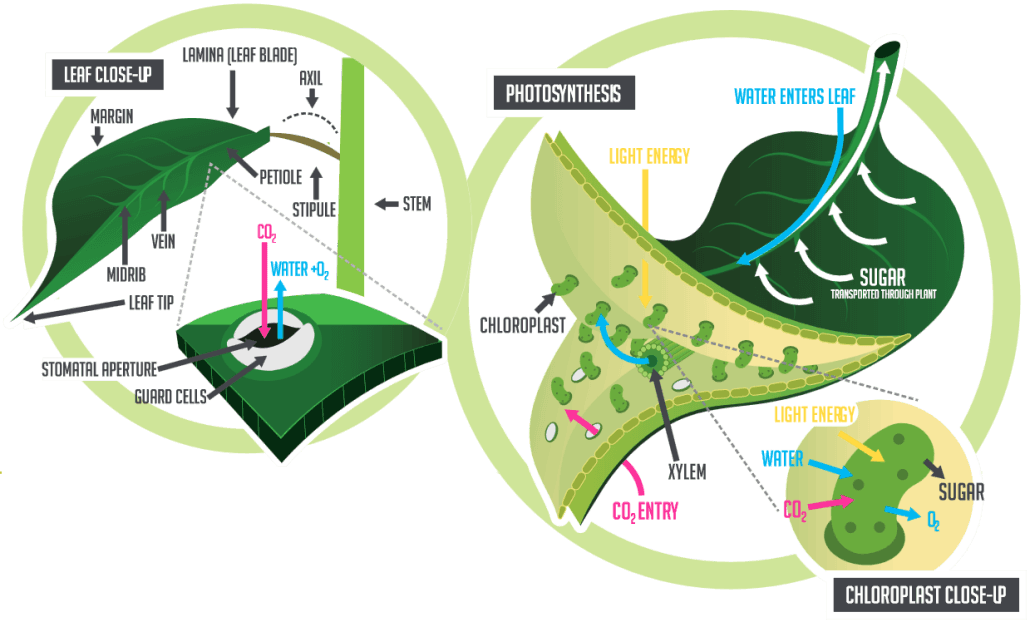
Introduction
An understanding of a plant as a living system is the foundation of becoming a successful grower. Knowing how plants work, observing their development, and responding appropriately to their needs is the alpha and omega of good gardening.
Over Ground, Under Ground

Photosynthesis:
The process of converting energy in sunlight into chemical forms of energy that can be used by biological systems in order to grow and develop.
Above Ground: Leaves, Transpiration and Photosynthesis
A plant’s leaves contain millions of tiny light converters called chloroplasts. These microscopic bio-factories convert light energy into a form of chemical energy that is then used to power other essential plant processes. During the daytime a plant absorbs carbon dioxide from the atmosphere (the carbon is used as a building block to create more plant matter) and emits oxygen as a by-product. This process reverses at night (plants absorb oxygen and emit carbon dioxide.) These gas exchanges occur through tiny holes in the leaf surface called “stomata.”
Stomata are also the site of transpiration. This is the process where a plant loses water to the surrounding atmosphere—like evaporation. Stomata open and close to regulate how much moisture is given up to the atmosphere. If conditions are hot and dry the stomata will close to protect the plant—this, in turn, has a direct effect on gaseous exchange and, thus, the amount of carbon available to the plant in order to grow and develop.

Below Ground: Roots, Water, Oxygen, and Nutrients
It’s a very different picture under the ground. In the absence of light, and insulated from the drying effect of the air, roots seek out moisture. Dissolved in this moisture are essential minerals which the plant uses as food. In soil, a complex array of microorganisms work to break down organic matter into inorganic (or ionic) forms that can be absorbed through the root hairs. In hydroponics, nutrients are supplied in ready-to-use ionic form so no microbiology is required. Mineral-rich moisture is transported throughout the plant via a network of channels called the vascular system.
Talking Plants

Plants do three main things: their leaves absorb sunlight and carbon dioxide (CO2) from the air, and their roots drink water containing dissolved mineral salts. This tri-fold process (called “photosynthesis”) results in the formation of glucose inside the plant. This glucose is stored as fuel for growing and blooming. Plants also expel oxygen (O2) as a by-product of this magical process!

At night (or when your grow lights are off) the opposite happens. Plants absorb oxygen and expel carbon dioxide. This intake of oxygen triggers the release of the stored glucose giving the plant the energy it needs to grow leaves, stem, flowers, fruit, and roots.
Understanding Plants: Three Special Things
1. They photosynthesize. Plants capture light energy and use it to create organic materials such as leaves, stem, buds, flowers, and fruit. They achieve this by combining carbon from the air (in the form of carbon dioxide) with hydrogen and oxygen from water to produce carbohydrates (plant fuel!) and oxygen. Crucially, it’s the energy from the light that drives this process.
2. They can grow to an indeterminate size. Whereas the size of animals or mammals is largely determined by genetics, plants can grow to become incredibly large if the environment is right. The sky is literally the limit with many plant species. When growing indoors it’s essential that growers adapt the growing environment to send the right cues to their plants (i.e. to grow stems and leaves or to produce flowers and fruit.)
3. They stay put! It may sound obvious but, once rooted, plants are anchored in place. As immobile organisms they have adapted ways to exploit the environment they find themselves in. When growing containerized plants be aware that it’s easy to ‘shock’ your plants with sudden changes in environment.

